Tsjerk
International Hazard
    
Posts: 3022
Registered: 20-4-2005
Location: Netherlands
Member Is Offline
Mood: Mood
|
|
Qualitative determination of lead in tap water
Water quality around here is very good, but especially in old city centers there are places with lead plumbing pipes. Since 1960 no new lead plumbing
has been installed, and governments have replaced any lead plumbing as good as they could, but they definitely missed some. Also not all home owners
have changed their plumbing.
I have been looking around, and you can have your water tested for around 50 euro, which I find a bit costly. Cheap home tests seem to have a lower
detection limit in the ppm range. Also doing the test myself would be more fun.
The levels I'm talking about are in the 10 ug/liter range. One of the methods to test for lead I found is with dithizone, which can be made with
phenylhydrazine, CS2 and KOH. I have these reagents, although apparently one of the steps is to determine the transition of H2S to NH3 gas production
by smell... that could also be done with litmus paper I guess. Also there is a warning about violent decomposition of the product.
Does anyone know of an easier way to test for low concentrations of lead?
Other trace metals in the water could be copper, iron and nickel. No chlorine or fluorides are used here. There is quite a bit CaCO3 in the water
here.
Dithizone lead determination
Dithizone synthesis
|
|
|
EthidiumBromide
Harmless

Posts: 42
Registered: 27-9-2020
Member Is Offline
Mood: Effervescent
|
|
Rhodizonates (sodium, potassium) are very sensitive towards lead, the lead salt is deeply red-violet coloured and can even detect traces of lead, e.g.
gunshot residues or distingiushing bullet wounds from other types of wounds. Not sure how well it would translate to water samples, though maybe
evaporation of the water and testing the leftover solids for lead could work, if you're only after a qualitative test?
Nurdrage has made a video about the preperation of rhodizonate salt (I think it was potassium rhodizonate), you should check it out, it's fairly
simple and straightforward.
Here's the vid: https://www.youtube.com/watch?v=BLmycZ2nrt0
He also showed using this solution to test for presence of lead in solder
|
|
|
unionised
International Hazard
    
Posts: 5102
Registered: 1-11-2003
Location: UK
Member Is Offline
Mood: No Mood
|
|
I think I would be more worried about the cyanide (and, to a lesser extent,the barbital) in the buffer than I would be about the lead.
Part of the problem with dithizone is that it's not specific.
|
|
|
teodor
National Hazard
   
Posts: 872
Registered: 28-6-2019
Location: Heerenveen
Member Is Offline
|
|
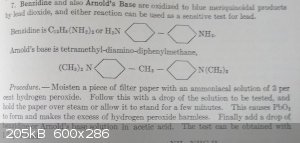
I didn't try it by myself.
|
|
|
Tsjerk
International Hazard
    
Posts: 3022
Registered: 20-4-2005
Location: Netherlands
Member Is Offline
Mood: Mood
|
|
Quote: Originally posted by unionised  | I think I would be more worried about the cyanide (and, to a lesser extent,the barbital) in the buffer than I would be about the lead.
Part of the problem with dithizone is that it's not specific. |
They also use the dithizone without buffer, but yes, interference by other metals could be a problem... In this link they use a biphasic extraction procedure, but they do state that 1 mg of Cu shouldn't interfere.
I think the buffer is needed to reduce interference by other metals.
The rhodizonate looks interesting!
I'm not too worried about the lead, but I know people who buy bottled water for them and their cat because they don't trust the water. 10 ug/l is the
maximum lead concentration the water is aloud to contain when it is delivered. But 100-1000 ug/l is not unheard of after standing during the night in
some residential lead plumbing.
|
|
|
Swinfi2
Hazard to Others
  
Posts: 131
Registered: 19-2-2018
Location: England
Member Is Offline
Mood: Catalytic
|
|
I'd definitely go the rhodizonate route, Iirc I think its vitamin b6 C6H12O6, oxidised with nitric acid. Goes dark red/brown and is specific to lead.
I'd have made some already but nitric acid isnt available to me.
|
|
|
Tsjerk
International Hazard
    
Posts: 3022
Registered: 20-4-2005
Location: Netherlands
Member Is Offline
Mood: Mood
|
|
I will receive some inositol tomorrow, I will update when I get to test some lead.
First lets get some lead in solution to use as a standard.
Inositol was considered a vitamin, B8, but was later found not to be essential.
|
|
|
AJKOER
Radically Dubious
    
Posts: 3026
Registered: 7-5-2011
Member Is Offline
Mood: No Mood
|
|
One path is to investigate just add KI (or NaI) and see if any bright yellow PbI2 is formed (see https://en.wikipedia.org/wiki/Lead(II)_iodide ).
-----------------------------------------------------------
Also, more reagent friendly, but needs to be tested for minor detection ability is just add NaOCl to a soluble Pb salt. For example:
Pb(HCO3)2 + 2 NaOCl -> Pb(OCl)2 (s) + 2 NaHCO3
A white precipitate of Lead hypochlorite, Pb(ClO)2 forms which on mild heating is converted into red PbO2. Source, please see http://bcs.whfreeman.com/WebPub/Chemistry/ichem5e/Videos/Hyp... , to quote:
"Initially, lead(II) ion reacts with hypochlorite ion to give a white precipitate of lead(II) hypochlorite:
Pb2++(aq) + 2 ClO-(aq) --> Pb(ClO)2(s)
The lead(II) hypochlorite is then oxidized to lead(IV) oxide. Reaction is slow at room temperature but much faster when the tube is placed in boiling
water.
Pb2+(aq) + 2 H2O(l) --> PbO2(s) + 4 H+(aq) + 2 e-
ClO-(aq) + 2 H+(aq) + 2 e- --> Cl-(aq) + H2O(l) "
Unfortunately, common chlorine based bleach has added NaOH for stability, and as a result expect also:
Pb(HCO3)2 + 2 NaOH -> Pb(OH)2 (s) + 2 NaHCO3
--------------------------------------------------
I suspect that a Marsh like test (see https://en.wikipedia.org/wiki/Marsh_test) employed here for Pb in place of As likely does not work.
If it does, the chemistry would be based on the creation of the hydrogen radical (.H) from say the action of NaOH or HCl on Zn (or, may I suggest
pehaps Al in place of Zn).
The underlying chemistry could then proceed as follows:
.H <=> H+ + e-
Pb(HCO3)2 + 2 .H -> Pb (s) + 2 H2O + 2 CO2 (g)
Note: problematic formation of Plumbane, PbH4, is not likely, unlike AsH4. See https://en.wikipedia.org/wiki/Plumbane .
So, the question still remains, how does one make the minor amount of Pb metal (or its ions) more visible with common inexpensive chemicals other than
an I- or OCl-?
|
|
|
teodor
National Hazard
   
Posts: 872
Registered: 28-6-2019
Location: Heerenveen
Member Is Offline
|
|
Quote: Originally posted by AJKOER  | One path is to investigate just add KI (or NaI) and see if any bright yellow PbI2 is formed (see https://en.wikipedia.org/wiki/Lead(II)_iodide ).
|
Of course at 10 microgram per litre range it will stay perfectly dissolved.
Quote: Originally posted by AJKOER  |
Unfortunately, common chlorine based bleach has added NaOH for stability, and as a result expect also:
Pb(HCO3)2 + 2 NaOH -> Pb(OH)2 (s) + 2 NaHCO3
|
In the presence of oxidiser (NaOCl) Pb(OH)2, I expect, will be also converted to PbO2.
The problem of detection of 10 ug PbO2 is not easier so than detection of any other Pb+ but now you also have bleach contamination to destroy more
sensitive tests.
[Edited on 19-10-2020 by teodor]
|
|
|
unionised
International Hazard
    
Posts: 5102
Registered: 1-11-2003
Location: UK
Member Is Offline
Mood: No Mood
|
|
Quote: Originally posted by AJKOER  | One path is to investigate just add KI (or NaI) and see if any bright yellow PbI2 is formed (see https://en.wikipedia.org/wiki/Lead(II)_iodide ).
-----------------------------------------------------------
Also, more reagent friendly, but needs to be tested for minor detection ability is just add NaOCl to a soluble Pb salt. For example:
Pb(HCO3)2 + 2 NaOCl -> Pb(OCl)2 (s) + 2 NaHCO3
A white precipitate of Lead hypochlorite, Pb(ClO)2 forms which on mild heating is converted into red PbO2. Source, please see http://bcs.whfreeman.com/WebPub/Chemistry/ichem5e/Videos/Hyp... , to quote:
"Initially, lead(II) ion reacts with hypochlorite ion to give a white precipitate of lead(II) hypochlorite:
Pb2++(aq) + 2 ClO-(aq) --> Pb(ClO)2(s)
The lead(II) hypochlorite is then oxidized to lead(IV) oxide. Reaction is slow at room temperature but much faster when the tube is placed in boiling
water.
Pb2+(aq) + 2 H2O(l) --> PbO2(s) + 4 H+(aq) + 2 e-
ClO-(aq) + 2 H+(aq) + 2 e- --> Cl-(aq) + H2O(l) "
Unfortunately, common chlorine based bleach has added NaOH for stability, and as a result expect also:
Pb(HCO3)2 + 2 NaOH -> Pb(OH)2 (s) + 2 NaHCO3
--------------------------------------------------
I suspect that a Marsh like test (see https://en.wikipedia.org/wiki/Marsh_test) employed here for Pb in place of As likely does not work.
If it does, the chemistry would be based on the creation of the hydrogen radical (.H) from say the action of NaOH or HCl on Zn (or, may I suggest
pehaps Al in place of Zn).
The underlying chemistry could then proceed as follows:
.H <=> H+ + e-
Pb(HCO3)2 + 2 .H -> Pb (s) + 2 H2O + 2 CO2 (g)
Note: problematic formation of Plumbane, PbH4, is not likely, unlike AsH4. See https://en.wikipedia.org/wiki/Plumbane .
So, the question still remains, how does one make the minor amount of Pb metal (or its ions) more visible with common inexpensive chemicals other than
an I- or OCl-? |
AJKOER,
Did you think any of that was actually useful for measuring lead in drinking water?
|
|
|
AJKOER
Radically Dubious
    
Posts: 3026
Registered: 7-5-2011
Member Is Offline
Mood: No Mood
|
|
Unionised [EDIT] and Teodor:
Thanks for the feedback as likely one does have to boil down the solution, which is an inconvenient, but perhaps necessary feature barring no other
options.
Also, the introduction of iodide maybe still be the basis of a comparative test. For instance, to quote Wikipedia (https://en.wikipedia.org/wiki/Iodine#Iodine_oxides_and_oxoac...):
"iodide is the best leaving group among the halogens, to such an extent that many organoiodine compounds turn yellow when stored over time due to
decomposition into elemental iodine; as such, they are commonly used in organic synthesis, because of the easy formation and cleavage of the C–I
bond.[58]"
So, even if the PbI2 is soluble, its relative stability under UV light introducing a brown coloration, may be distinct from a test solution, not
having a Pb presence, where one is assumed to start with a less light sensitive iodine salt. Or, working in the opposite direction, start with a very
small amount of say AgI, which is highly light-sensitive. A comparative degradation in light sensitivity may indicate other iodide formation,
including PbI2, but again as Unionised noted the soluble iodide photolysis test is not specific.
Just ideas based on available reagents for testing.
[Edited on 19-10-2020 by AJKOER]
[Edited on 19-10-2020 by AJKOER]
|
|
|
teodor
National Hazard
   
Posts: 872
Registered: 28-6-2019
Location: Heerenveen
Member Is Offline
|
|
AJKOER: Comment about PbI2 solubility was made by me, not by unionised. But it seams you do mention unionised twice: the first time as a user and the
second time as PbI2 .
Also you should consider silicate gel formation when boiling down tap water, they are more copious than any heavy metal salts.
[Edited on 19-10-2020 by teodor]
|
|
|
AJKOER
Radically Dubious
    
Posts: 3026
Registered: 7-5-2011
Member Is Offline
Mood: No Mood
|
|
Teodor:
I have edited my comment, so you and Unionised get credit for my not citing the likely necessary part of concentrating down the solution (possibly by
natural evaporation with large surface air contact).
A solution that has been concentrated containing aqueous PbI2 has a coloration of orange/yellow, but one has still to test the feasibility and
accuracy of any proposed method, in my opinion.
|
|
|
teodor
National Hazard
   
Posts: 872
Registered: 28-6-2019
Location: Heerenveen
Member Is Offline
|
|
AJKOER: I don't quite understand why the solution should be colored if PbI2 is not formed, because PbI2 formation probably means only crystallization.
Do you expect it could be present in _unionised_ state in the solution (forgive me, I am not so smart in theory)?
Edit: should I also to mention action of dissolved oxygen and organic peroxides on I- ions?
[Edited on 19-10-2020 by teodor]
|
|
|
teodor
National Hazard
   
Posts: 872
Registered: 28-6-2019
Location: Heerenveen
Member Is Offline
|
|
"Standard Methods for the Examination of Water, Sewage, and Industrial Wastes" 10th edition 1955.
If you think it is useful I'll make a better scan.
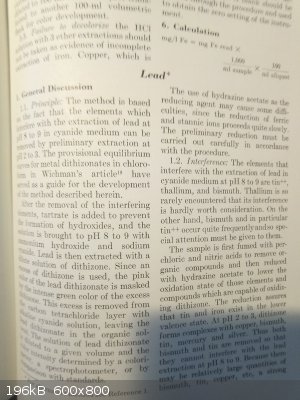 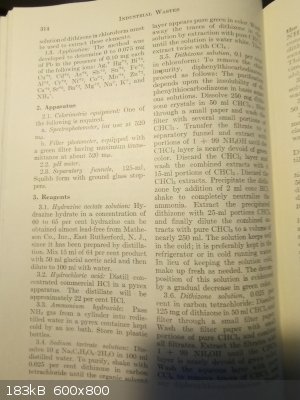 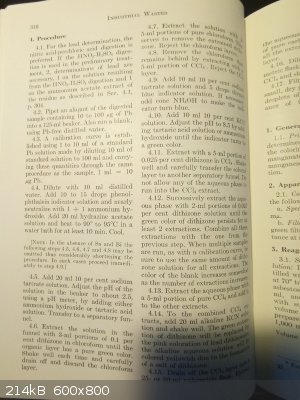 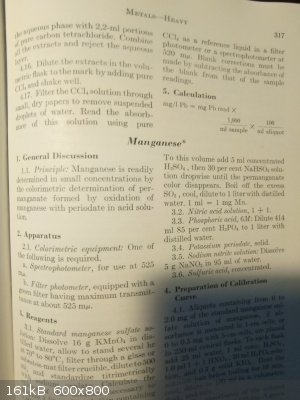
[Edited on 19-10-2020 by teodor]
|
|
|
Tsjerk
International Hazard
    
Posts: 3022
Registered: 20-4-2005
Location: Netherlands
Member Is Offline
Mood: Mood
|
|
Thanks teodor! I will first try rhodizonate, but will keep the dithizonate in mind.
@AJOEKER: to get PbI2 to precipitate from a 10 ug/l solution you have to concentrate approximately 25.000 times. That is 25 liters to 1 milliliter...
That same amount of water contains about 4 grams of CaCO3. After that concentration you would have about .5 mg of PbI2.
Quote: Originally posted by AJKOER  |
So, the question still remains, how does one make the minor amount of Pb metal (or its ions) more visible with common inexpensive chemicals other than
an I- or OCl-? |
With 10 euro worth of inositol, a bit of nitric acid, potassium acetate and optionally a bit of strontium? It is all in the posts above yours.
[Edited on 19-10-2020 by Tsjerk]
|
|
|
teodor
National Hazard
   
Posts: 872
Registered: 28-6-2019
Location: Heerenveen
Member Is Offline
|
|
"Add 5 mL 0.1N iodine solution to avoid losses of volatile organo-lead compounds during handling and digesting of samples." - from your 4th link,
Tsjerk .
So, you are definitely right AJKOER in the core of your idea.
[Edited on 19-10-2020 by teodor]
|
|
|
Dr.Bob
International Hazard
    
Posts: 2656
Registered: 26-1-2011
Location: USA - NC
Member Is Offline
Mood: No Mood
|
|
Perhaps look at one of these and see what patents it lists or if they have a MSDS that contains the ingredients.
https://www.coleparmer.com/i/emd-millipore-10077-1-water-tes...
or
https://www.homedepot.com/p/PRO-LAB-Total-Water-Quality-Test...
or
https://www.homedepot.com/p/Protect-Plus-Complete-Water-Anal...
|
|
|
AJKOER
Radically Dubious
    
Posts: 3026
Registered: 7-5-2011
Member Is Offline
Mood: No Mood
|
|
For the more advanced researcher, some new tools to work with, for example, to quote:
"Another example of the use of a fullerene column for Pb speciation (inorganic Pb and ionic alkyl lead compounds) was in rainwater [29], with the
objective of the preconcentration of Pb forming diethyldithiocarbamate (DDTC) complexes followed by FAAS as a screening strategy using C60 fullerene."
Source: https://www.sciencedirect.com/topics/materials-science/fulle...
And, a little more background at https://www.sciencedirect.com/science/article/pii/B978008101... .
[Edited on 2-11-2020 by AJKOER]
|
|
|